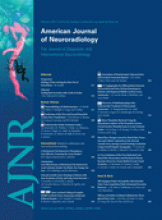Abstract
BACKGROUND AND PURPOSE: CTA-SI have been previously reported to correlate with CBV. We hypothesized that CTA-SI performed by modern multisection CT scanners are CBF-, not CBV-weighted.
MATERIALS AND METHODS: Sixty-four consecutive patients with anterior circulation stroke symptoms were selected from a stroke data base between June 2007 and January 2009. Two independent blinded readers calculated defect volumes of CTA-SI and PCCT, CBF, and CBV images. Spearman correlation of lesion volumes was performed. Linear regression and residual analysis demonstrated factors associated with outliers for CTA or PCCT for CBF and CBV volumes.
RESULTS: We found a strong positive correlation between CTA with CBF (r = 0.89, P < .0001) and between PCCT and CBV (r = 0.79, P < .0001). CTA to CBV (r = 0.5, P < .0001) and PCCT to CBF (r = 0.52, P < .0001) correlations were weaker. Positive CTA outliers had lower ASPECTS (P = .01), larger baseline CTA (149 ± 46 cm3 versus 83 ± 32 cm3; P = .002, respectively), and final infarct (190 ± 100 cm3 versus 80 ± 50 cm3; P = .09, respectively) volumes than nonoutliers. No baseline features were significantly related to PCCT outliers. There was no difference in the vessel occlusion sites for positive or negative outliers for CTA or PCCT (P = .55 and P = 1.00, respectively).
CONCLUSIONS: Our results indicate that CTA-SI are CBF- rather than CBV-weighted.
Abbreviations
- ACA
- anterior cerebral artery
- ASPECTS
- Alberta Stroke Program Early CT Score
- AUC
- area under the curve
- CBF
- cerebral blood flow
- CBV
- cerebral blood volume
- CTA
- CT angiography
- CTA-SI
- CT angiographic source images
- DWI
- diffusion-weighted imaging
- ICA
- internal carotid artery
- IQR
- interquartile range
- log
- log-transformed
- MCA
- middle cerebral artery
- MDCT
- multidetector row CT
- min
- minutes
- NCCT
- noncontrast CT
- NIHSS
- National Institutes of Health Stroke Scale
- PCCT
- postcontrast CT
- Q1–Q3
- interquartiles 1–3
- rtPA
- recombinant tissue plasminogen activator
- Copyright © American Society of Neuroradiology












